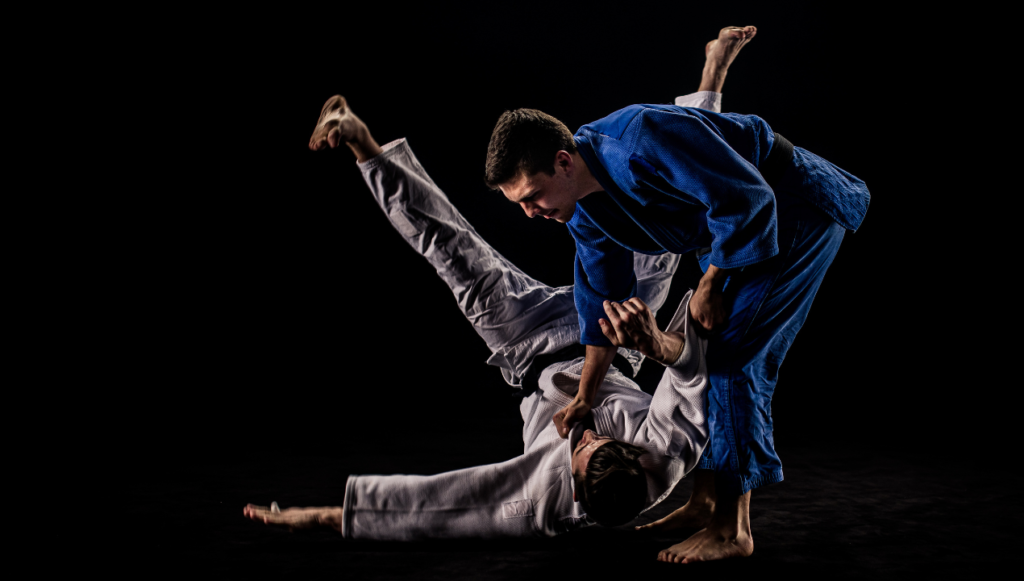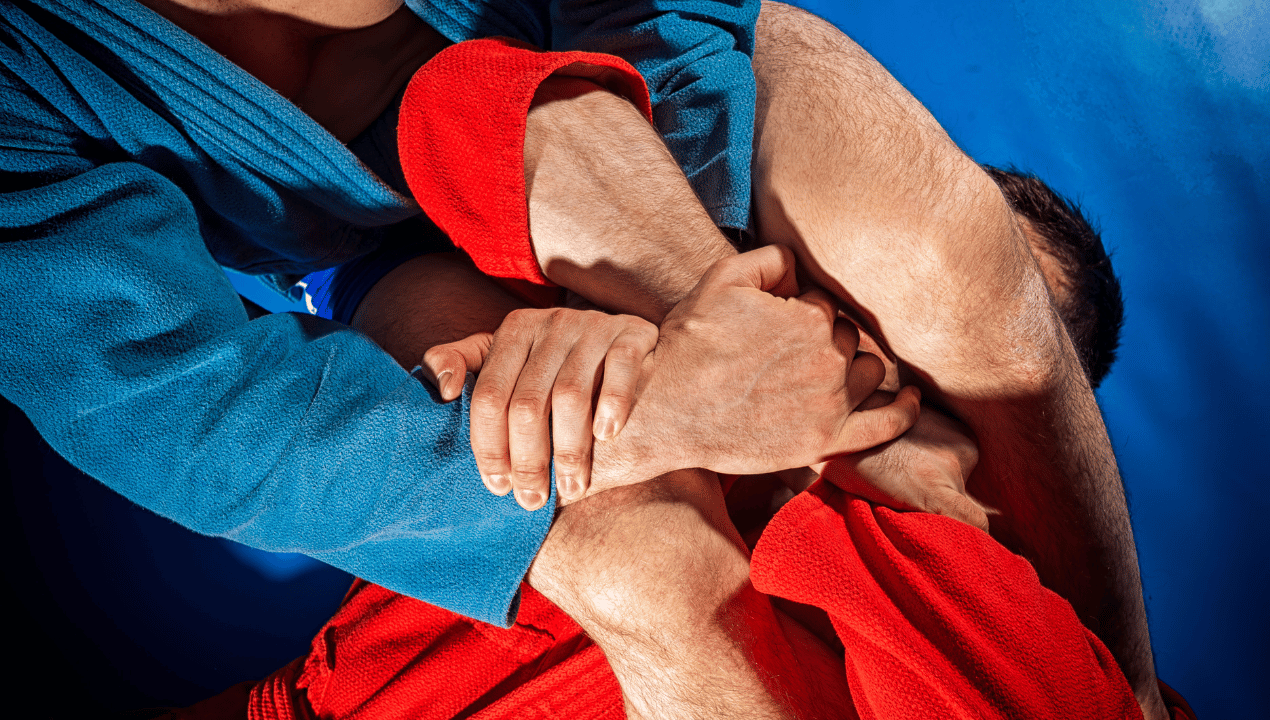From the military training grounds of Vladimir Lenin to the UFC octagon, Sambo wrestling has come a long way. But what is sambo? And why is it so effective?
In this exhaustive and comprehensive history of Sambo wrestling, we’ll dive into why it was created and touch on some of the foundational reasons it continues to grow in popularity today.
What is Sambo?
Sambo is a modern martial art and combat sport that originated in the Soviet Union.
It’s a Russian acronym for the phrase Samozashchita Bez Oruzhiyathat which translates to “self-defense without weapons.”
Although it’s a relatively new combat sport not so common outside former Soviet Republics, it’s believed to be the third most popular international wrestling style. And has been showcased in dominating fashion in the UFC by former champion Khabib Nurmagomedov.
What Are The Objectives of Sambo?
Sambo is all about taking your opponent to the ground and quickly executing a submission hold.
People who practice Sambo are known for three specific characteristics: leg locks, a seamless combination of Judo and other wrestling maneuvers, and fundamental control abilities.

As we’ll cover later, different styles of Sambo may add in other techniques, like striking for combat style Sambo, but the focus and foundation are always in grappling.
History of Sambo
Inspired by Judo and Japanese Jujutsu (Jiu Jitsu), Sambo was initially designed for military use in the 20th century.
It was designed to combine multiple martial arts into the most efficient system.
Russia is near Europe and Asia, so it’s always been a hub for various fighting styles and techniques.
Throughout history, the country has enjoyed the presence of Mongols, Vikings, Japanese, Tartar, and other friendly folks.
And the combat styles and fighting systems of these battle-savvy civilizations served as a strong foundation for Russian Sambo.
Sambo Founding Fathers
In 1923, four Russian martial arts experts, Spiridonov, Oschepkov, I.V. Vasiliev, and Anatoly Kharlampiyev, joined forces to develop a new unarmed combat system for the Red Army under Vladimir Lenin.

Victor Spiridonov was a highly experienced wrestler with a unique perspective after an injury in WW1 left his left arm useless. Much like Helio Gracie when creating BJJ, this forced him to develop a softer style known as ‘Samoz’ that allowed an injured or weaker person to use an opponent’s strength against them.
Vasili Oshchepkov, the other ‘father’ of Sambo, was a Red Army Karate and Judo instructor. Oshchepkov was known for his combat abilities combining moves and skills from Judo, Karate, Greco-Roman Wrestling, and several native-Russian wrestling techniques. Oshchepkov was one of the first non-Japanese second-degree Judo Black Belts in history.
Although Spiridonov and Oshchepkov were arguably most instrumental to the development of Sambo, Anatoly Kharlampiev is often credited as the “father of Sambo”.
This is due to his political maneuvering and unwavering commitment to martial arts development. It was Kharlampiev who campaigned for Sambo to be recognized as the official combat sport of the Soviet Union. And in 1938, it was made official.
Sambo was soon taught to the military, police, and other organizations after its techniques were refined and cataloged. However, the techniques were sometimes modified to meet the specific needs of different groups. This led to the creation of various subtypes of Sambo.
Types of Sambo
There are multiple types of Sambo, but the two most widely known are Sport Sambo and Combat Sambo.
Sport Sambo
Sport Sambo is similar to Judo and wrestling and mainly focuses on takedowns with powerful throws, grappling, especially with leg locks, and takedown defenses. However, chokeholds are not allowed.
As you’d expect by the name, this is the form of Sambo used in competition.
Combat Sambo
Combat Sambo is the original and more aggressive form created for military use in real combat. It includes striking and grappling, with effective techniques such as elbow, knees, kicks (similar to Muay Thai but without leg kicks), and even dirty tactics like groin strikes and headbutts.
It’s the one most commonly learned for self-defense and MMA enthusiasts and has some deep similarities to Krav Maga.
Freestyle Sambo
Freestyle Sambo allows all combat techniques used in Sport or Combat Sambo, including submission, striking, and grappling. With an emphasis on throws for takedowns and leg locks.
However, strikes are not allowed in competition, while even neck cranks and twisted leg holds are.
Self-Defense Sambo
Self-Defense Sambo teaches practitioners how to defend themselves against weapons and other dangerous attacks.
Like its founder, Spiridonov, this form of Sambo is a comprehensive style meant to use an attacker’s aggression against them – like Ip Man.
Special Sambo
Special Sambo was created for rapid response law formations and Army Special Forces. And so it’s closely related to Combat Sambo.
Sambo in the USA
Sambo was exported out of Russia in the 1960s when practitioners of the fighting style competed in international Judo competitions.
In 1968, the International Federation of Associated Wrestling Styles recognized Sambo, Judo, and Greco-Roman wrestling as an international style.
That same year, Boris Timoshin, a Russian-born politician and Sambo champion, traveled to the United States to seek a career in Sambo instruction.
He eventually found a place to train and teach Sambo at the YMCA in New York City. And by the mid-1980s, Sambo had grown in popularity to the point of forming the International Sambo Federation in 1985.
But Sambo’s recognition and popularity really started when Oleg Taktarov, a Russian black belt in Judo and Sambo competitor, won the UFC 6 in 1995 (see more notable Judo fighters in the UFC here).
Today, two large American Sambo organizations exist: the All-American Sambo Federation and USA Sambo.
Sambo Belt System
Sambo is a martial art with seven ranks, each held for a year. They don’t have a colored belt system like BJJ, though, and instead, use a system similar to wrestling (learn all about the differences of wrestling vs BJJ here).
The first rank is a Rookie belt, followed by six more levels until the seventh year, the second Master level.
Those who excel in Sambo can earn titles such as “master of sport” or “international master of sport” from recognized organizations at the national and international level.
So, if you have a passion for Sambo, work hard, and improve your skills, you too could become a master of sport or an international master of sport in 7 years or so.
What Do Sambo Wrestlers Wear?
Sambo wrestlers wear a specific uniform called “kurtka” (jacket), “sambovka” (shorts), and “sambo shoes” (wrestling shoes).
The kurtka is a thick, heavy jacket made of durable material, usually cotton (very different from the singlets used in American amateur wrestling), and comes in red or blue to distinguish between competitors.
The sambovka is a pair of short, tight-fitting shorts, usually made of the same material as the kurtka, and also colored red or blue.
Sambo shoes are soft, light, and flexible wrestling shoes designed to provide traction and support on the mat. The color of the shoes typically matches the rest of the competitor’s outfit.
Common Rules in Sambo Competitions
Victory comes in various ways:
- A perfect throw that sends your opponent to the ground while you remain standing (ala Judo).
- A 12-point lead will also result in a win,
- Submission of an opponent,
- Or gain more points than opponents through Sambo techniques like throws, takedowns, and holds before the time runs out.
In Combat Sambo, throws and pins are the primary methods for earning points.
Pins are awarded 2 points if the opponent is pinned for 11 to 19 seconds and 4 points if they are pinned for more than 20 seconds.
Throws are scored based on your position during and after the throw and how your opponent falls. More points are given when you remain upright during and after the throw – commonly seen as the perfect throw.
What Techniques are Illegal in Sambo?
Certain techniques are illegal in sport sambo:
- Chokes
- Heel hook
- Reverse heel hook
- And other twisting leg locks
- Calf Crusher
- Neck Cranks
Stalling, such as in a closed guard, is also grounds for penalization in a competition.
Sambo in MMA
Sambo is a great martial art for cross – training and has proven to be an excellent introduction to MMA.
Perhaps the most famous and successful examples of Sambo MMA fighters are Fedor Emelianenko, four-time World Combat Sambo Champion, and six-time Russian national Combat Sambo Champion.
And Khabib Nurmagomedov, a two-time World Combat Sambo Champion and a Russian UFC Champion.
And current lightweight champion Islam Makachev. A close training partner of Khabib and Sambo expert.
These three are celebrated for their incredible achievements and are commonly debated as pound-for-pound greats.
Why is Sambo so Effective?
Sambo training is not for the faint of heart.
It’s hardcore, intense, and will push you to your limits. But the rewards are immense.
As a martial art created for real-world combat, it’s no surprise that Sambo is second to none regarding self-defense.
Its emphasis on striking, grappling, kicks, and weapon-disarming techniques makes it a complete combat system that will prepare you for any situation.
One aspect that sets Sambo apart from other martial arts is its use of takedowns with all parts of the body, including the legs and head.
This makes it a versatile and effective style that can be used in various situations, including street fighting.
While Judo may be the mother of Sambo and BJJ, Sambo, particularly Combat and Freestyle Sambo has fewer restrictions, making it a more brutal and practical martial art.
But the benefits of Sambo don’t end there. It’s also a great form of fitness training to help you develop strength, endurance, and agility.
And let’s not forget about the mental benefits. Sambo training requires discipline, focus, and determination, which will carry over into other areas of your life. So if you’re looking for a martial art that will challenge you physically and mentally, look no further than Sambo.
How to Learn Sambo?
Sambo is an exciting and challenging sport that requires rigorous combat training in grappling, striking, joint locks, throws, suffocation techniques, and strikes.
And while Sambo is arguably a defensive sport, it requires aggressive play, with success requiring a wide range of skills.
Learning Sambo takes dedication, motivation, determination, and patience. It’s not just about making the moves but gaining complete control over each skill and every move your body makes.
FAQ: What is Sambo?
Here are some answers to frequently asked questions about Sambo.
Is Sambo In The Olympics?
Not yet. There was a lot of buzz about the International Olympic Committee recognizing Sambo as an official Olympic sport in 1981 after a youth Sambo demonstration helped open the Summer Olympics in Moscow.
But unfortunately, it hasn’t happened yet. But, hope remains strong as the Sambo community continues to work hard and gain support, including from President Vladimir Putin himself, who is an honorary FIAT president. With such dedicated efforts and backing, who knows what the future holds for Sambo in the Olympics.
Is Sambo Safe For Kids?
Sambo is not just a sport; it’s a way of life! Sambo embodies values that go beyond the physical aspect of training.
It teaches its practitioners to respect themselves and others, to have self-discipline, and to strive for personal growth and development. It also fosters a sense of camaraderie and friendship among its practitioners from all walks of life. And that’s not all! Sambo’s intense training also boosts endurance, stamina, and strength, making it the perfect sport and self-defense technique for people of all ages. Whether you’re a child or an adult, Sambo can help you become the best version of yourself!
